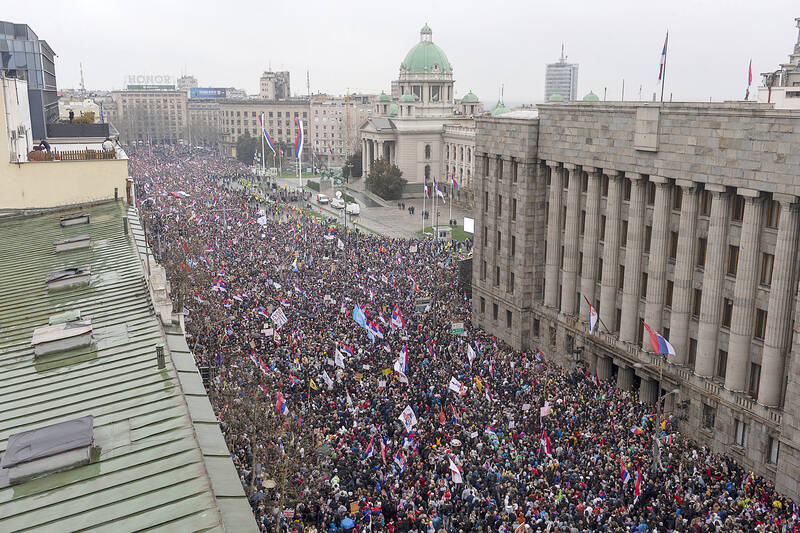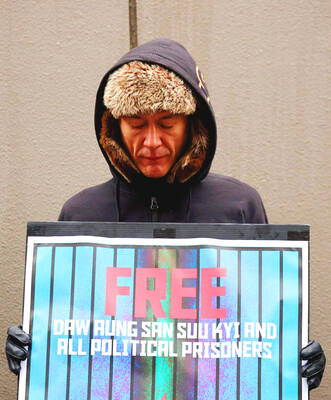A sea of people converged in Serbia’s capital, Belgrade, on Saturday in what was the largest in a series of anti-corruption demonstrations that have upended the Balkan country in recent months.
At one point the crowd stretched for nearly two kilometers, with people filling the streets in and around the parliament and the capital’s main pedestrian square.
“We have gathered in the streets primarily to express our complete dissatisfaction after years of dictatorship, lawlessness and corruption,” said one demonstrator, Ognjen Djordjevic, a 28-year-old resident from Belgrade.

Photo: AP
The movement formed after 15 people were killed when a railway station roof collapsed in the city of Novi Sad in November last year, igniting long-simmering anger over alleged corruption and lax oversight in construction projects.
After Saturday’s rally, the Serbian Ministry of Internal Affairs said that at least 107,000 people had turned out.
The Public Assembly Archive — a group that monitors crowd size — gave a much higher figure, estimating that between 275,000 and 325,000 people took to the streets. If correct, that would make Saturday’s protest one of the largest in Serbia’s recent history.
For weeks, student-led protesters have crisscrossed the country, holding rallies in Serbia’s major cities.
They have also taken their anti-corruption crusade to the rural areas and small towns that have long been the backbone of Serbian President Aleksandar Vucic’s support.
Their return to Belgrade on Saturday ramped up already compounding pressure on Vucic’s government, with several high-ranking officials, including the prime minister, Milos Vucevic, having resigned in recent months.
Saturday’s protest, like the others before it, cut across a wide spectrum of society, bringing together those aligned with the far left and right. Amid scores of Serbian flags, some waved banners calling for environmental protection, while others demanded the return of the former breakaway province of Kosovo.
Following hours of peaceful protests, police reported that there had been some “incidents and clashes among some participants” of the protests.
At about 7:20pm, a leading student group called on all protesters to exit the area near the parliament, citing security concerns after bottles and stones were allegedly thrown. The reports of scattered incidents came as fears rose over potential clashes with supporters of Vucic’s embattled government, who had also gathered in the capital.
In the days leading up to the protest, ultranationalists and militia members camped out near the parliament and the Novi Dvor, the seat of the presidency.
Ahead of the protest, layers of riot police earlier fanned out near the encampment and around the parliament.
Late on Saturday, Vucic took to the airways again.
“There were no casualties or serious injuries,” Vucic said during the national address.
“I’m proud of the police who ensured security for all participants,” he said, adding that he believed “99 percent” of students had remained peaceful.
A day earlier, Vucic had struck a defiant tone, saying he would not “let the streets set the rules in this country.”
Some analysts had earlier warned that the situation would escalate. “We can already see for a few days that the regime is trying to escalate tensions,” political analyst Srdjan Cvijic said.
Government-backed media also broadcasted increasingly inflammatory accusations, saying the students are planning to launch a “coup,” with Vucic accusing the demonstrators of organizing “large-scale violence.”
However, the day passed with no major incidents. Farmers, students, bikers and other civilians mingled along the main thoroughfares in downtown Belgrade, as a parade of tractors headed toward the parliament as crowds amassed.
Ahead of the main afternoon protest, thousands also stood for 15 minutes of silence beginning at 11:52am to honor the victims of the Novi Sad incident, with the time marking the moment of the roof’s collapse.
The ritual was repeated in the evening, as a sprawling crowd at a major traffic roundabout waved their illuminated mobile phones in the air.
“We came for justice,” said Milica Stojanovic, a biology student at the University of Belgrade. “I hope that after this protest, things will change.”

The Burmese junta has said that detained former leader Aung San Suu Kyi is “in good health,” a day after her son said he has received little information about the 80-year-old’s condition and fears she could die without him knowing. In an interview in Tokyo earlier this week, Kim Aris said he had not heard from his mother in years and believes she is being held incommunicado in the capital, Naypyidaw. Aung San Suu Kyi, a Nobel Peace Prize laureate, was detained after a 2021 military coup that ousted her elected civilian government and sparked a civil war. She is serving a

China yesterday held a low-key memorial ceremony for the 1937 Nanjing Massacre, with Chinese President Xi Jinping (習近平) not attending, despite a diplomatic crisis between Beijing and Tokyo over Taiwan. Beijing has raged at Tokyo since Japanese Prime Minister Sanae Takaichi last month said that a hypothetical Chinese attack on Taiwan could trigger a military response from Japan. China and Japan have long sparred over their painful history. China consistently reminds its people of the 1937 Nanjing Massacre, in which it says Japanese troops killed 300,000 people in what was then its capital. A post-World War II Allied tribunal put the death toll

‘NO AMNESTY’: Tens of thousands of people joined the rally against a bill that would slash the former president’s prison term; President Lula has said he would veto the bill Tens of thousands of Brazilians on Sunday demonstrated against a bill that advanced in Congress this week that would reduce the time former president Jair Bolsonaro spends behind bars following his sentence of more than 27 years for attempting a coup. Protests took place in the capital, Brasilia, and in other major cities across the nation, including Sao Paulo, Florianopolis, Salvador and Recife. On Copacabana’s boardwalk in Rio de Janeiro, crowds composed of left-wing voters chanted “No amnesty” and “Out with Hugo Motta,” a reference to the speaker of the lower house, which approved the bill on Wednesday last week. It is

FALLEN: The nine soldiers who were killed while carrying out combat and engineering tasks in Russia were given the title of Hero of the Democratic People’s Republic of Korea North Korean leader Kim Jong-un attended a welcoming ceremony for an army engineering unit that had returned home after carrying out duties in Russia, North Korean state media KCNA reported on Saturday. In a speech carried by KCNA, Kim praised officers and soldiers of the 528th Regiment of Engineers of the Korean People’s Army (KPA) for “heroic” conduct and “mass heroism” in fulfilling orders issued by the ruling Workers’ Party of Korea during a 120-day overseas deployment. Video footage released by North Korea showed uniformed soldiers disembarking from an aircraft, Kim hugging a soldier seated in a wheelchair, and soldiers and officials